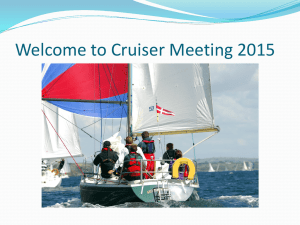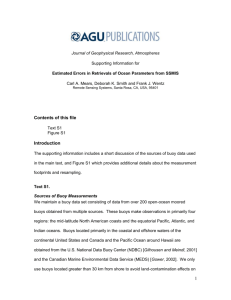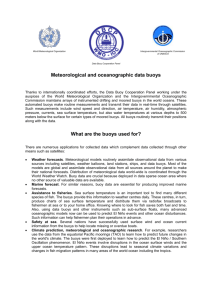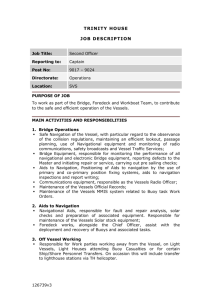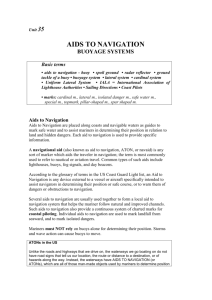Aids to Navigation - Ponce de Leon Lighthouse
advertisement
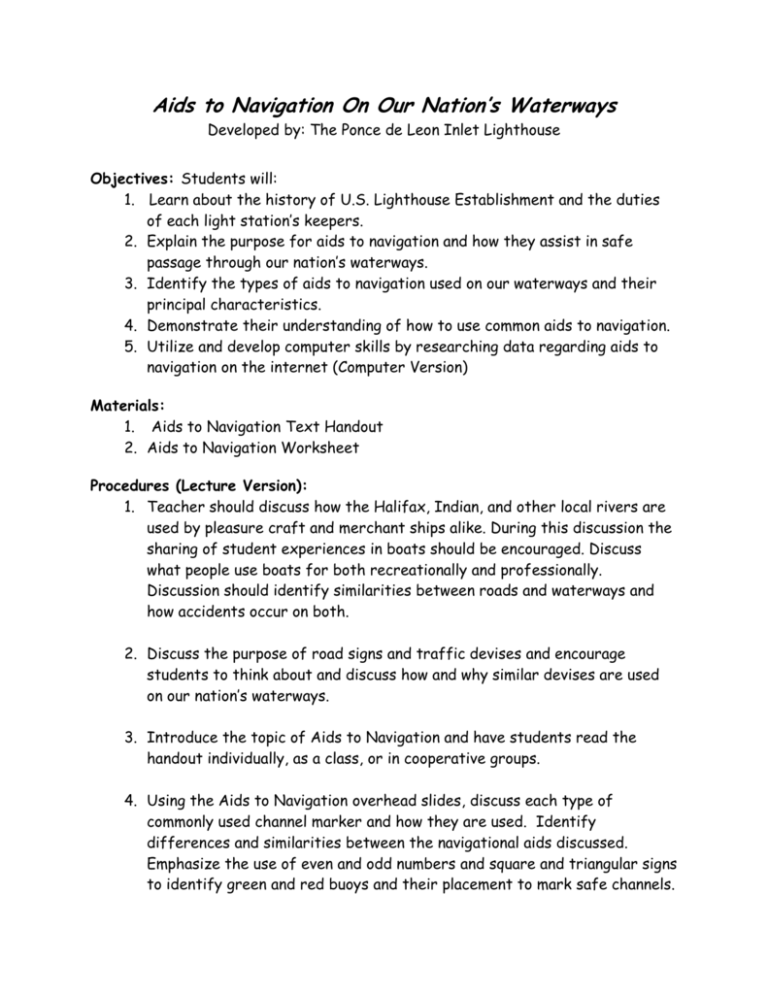
Aids to Navigation On Our Nation’s Waterways Developed by: The Ponce de Leon Inlet Lighthouse Objectives: Students will: 1. Learn about the history of U.S. Lighthouse Establishment and the duties of each light station’s keepers. 2. Explain the purpose for aids to navigation and how they assist in safe passage through our nation’s waterways. 3. Identify the types of aids to navigation used on our waterways and their principal characteristics. 4. Demonstrate their understanding of how to use common aids to navigation. 5. Utilize and develop computer skills by researching data regarding aids to navigation on the internet (Computer Version) Materials: 1. Aids to Navigation Text Handout 2. Aids to Navigation Worksheet Procedures (Lecture Version): 1. Teacher should discuss how the Halifax, Indian, and other local rivers are used by pleasure craft and merchant ships alike. During this discussion the sharing of student experiences in boats should be encouraged. Discuss what people use boats for both recreationally and professionally. Discussion should identify similarities between roads and waterways and how accidents occur on both. 2. Discuss the purpose of road signs and traffic devises and encourage students to think about and discuss how and why similar devises are used on our nation’s waterways. 3. Introduce the topic of Aids to Navigation and have students read the handout individually, as a class, or in cooperative groups. 4. Using the Aids to Navigation overhead slides, discuss each type of commonly used channel marker and how they are used. Identify differences and similarities between the navigational aids discussed. Emphasize the use of even and odd numbers and square and triangular signs to identify green and red buoys and their placement to mark safe channels. Discuss possible reasons behind the use of three different methods for identifying green and red channel markers. 5. Have students complete the Aids to Navigation data sheet. 6. Discuss how red and green buoys, day markers, and lighthouses all serve as aids to help ships safely navigate our waterways, inlets and coastlines. Demonstrate how ships use these Aids to Navigation to avoid dangerous obstacles such as shoals, wrecks, and sandbars. 7. Write the Acronym R.R.R and define it as “Red Right Return”. This is used by boaters to always remember to keep the red buoy and/or channel marker to their right whenever they are headed inland. 8. Hand out the map activity sheet for students to complete. During this activity, students will navigate their boat from the start point outside of the inlet to home port using the navigational aids located on the map. Refer to the teacher master to check student work. If the student’s course intersects with any of the black underwater obstacles explain where they made their error and have them try again. Students may also navigate their vessels from the port to the 2nd Destination. Review lesson with students following completion of activity using overhead of master map and discussing main points Good Sites for Information on Navigational Aids Include: Keelboat Course-Basic Navigation: www.sailingusa.info/basic_navigation.htm Sea Kayak- U.S. Aid to Navigation: www.seakayak.ws/kayak/kayak.nsf. U.S. Coast Guard Aids to Navigation: www.dirauxwest.org/Piloting/atons.html Aids to Navigation On Our Nation’s Waterways The U.S. Lighthouse Service is almost as old as the United States itself. In fact, many believed that lighthouses were so important they became one of the first things that the newly formed government focused on after ratifying the U.S. Constitution. Created by Congress in 1789, the Lighthouse Establishment was given responsibility for maintaining all aids to navigational in the United States. An Aid to Navigation is a device located on shore or in the water that helps a ship navigate safely from one point to another. These important aids come in many shapes and sizes including lighthouses, lightships, channel markers, and buoys. Lighthouse keepers led very busy lives. Not only were they required to keep the lighthouse’s beacon lit every night regardless of the weather, but they had many other duties as well. Daily chores included cleaning the delicate lens at the top of the lighthouse, hauling oil to the top of the tower, and cleaning the tower itself. Once the daily tower chores were done, keepers often moved on to other parts of the light station that needed work. These additional duties included routine repairs to all the buildings, walkways, fences, and boats that belonged to the light station. The days were long, the work was hard, and the job never seemed to be done. Included in the long list of keeper responsibilities were the maintenance and placement of all navigational aids that marked the waterways around the light station. Keepers assigned to the Ponce Inlet Light Station were required to take their boats out into the dangerous inlet several times a month to inspect the buoys and markers for which they were responsible. Keepers would take soundings throughout the inlet to ensure that the locations of channels and sandbars had not moved. A sounding is a process used to measure the depth of the water at any point using a long line attached to a heavy object. This was a very important part of the lighthouse keeper’s job because channels, which are deep grooves, cut into the bottoms of rivers, bays, lakes, or inlets, allowed ships to safely transit areas with shallow water without running aground. Soundings were also used to determine the location of shallow ridges of sand called sandbars which could pose a serious threat to maritime traffic. Navigation buoys and markers were used to help mariners identify the location of the channels through Ponce Inlet and to locate hazardous sandbars, rocks, and wreck sites that could easily sink their ship if struck. The incorrect placement of these navigational aids could prove disastrous, so keepers were on a constant vigil to ensure their proper placement throughout the inlet. After completing their soundings, keepers would move the buoys and markers if they discovered the channels or the sandbars had shifted to new locations. They would repair, repaint, or replace buoys, anchors and chains as necessary and notify sailors if any channels or sandbars had moved in the inlet in a booklet called the “Notice to Mariners”. A buoy is anything that floats. It is a lot like a bobber but bigger. For navigation purposes there are three types of buoys: channel buoys, wreck buoys, and danger buoys. A channel buoy can be lit or unlit and is either red or green. An illuminated green channel buoy is used to mark one side of a channel while the red illuminated buoy marks the other. All green channel buoys are numbered with odd numbers and feature a square green sign while red channel buoys have only even numbers with a red triangular sign. Unlit channel buoys have the same purpose as those that are lit but have different shapes. Green unlit channel buoys, referred to as “cans”, are shaped like a cylinder standing on end while their red counterparts, known as “nuns”, resemble cones. Channel Markers, which perform the exact same function as channel buoys are generally mounted on pilings and located in much shallower water. It is important to remember that all green navigation aids have odd numbers and square signs while red navigation aids have even numbers with triangular signs. Ships must stay between these two different markers to remain safely in the channel. Illuminated Green Channel Buoy Unlit Green “Can” Buoy Illuminated Green Channel Marker Unlit Square Channel Marker 12 Illuminated Red Channel Buoy Unlit Red “Nun” Buoy Illuminated Red Channel Marker Unlit Triangular Channel Marker In addition to navigation buoys and markers, lighthouse keepers were also required to monitor the location other natural and man-made hazards including wrecks and sandbars. Special buoys and markers were placed near these underwater hazards to warn ships to stay away. Sandbars and wrecks posed a major danger to ships trying to navigate through the inlet and keepers had to make sure that their positions were clearly marked to prevent future accidents. A Danger Marker or Buoy was identified by an orange sign with a white diamond or square with the word “Danger” or the letter “D” written in the middle of it. Shipwreck markers and buoys were identified by the letters “WR”. The color of a wreck marker or buoy was determined by what side of the channel it was on. Wrecks located on the red side of the channel had a red sign while those located on the other side of the channel were green. Although the United States Lighthouse Service was disbanded in 1939, its many maritime duties were taken over by the United States Coast Guard. Many lighthouse keepers chose to put on the Coast Guard uniform instead of retiring and continued to perform many of the same duties they had previously been responsible for as Lighthouse Service employees. Today, Coast Guard personnel routinely check the location, condition, and accuracy of navigational aids and offer boaters training on how to properly read these signs. Whenever you are on the water remember these important rules: 1. Remember the three R’s: “Red Right Return”- When Returning from the sea or lake always, keep the Red navigation buoys and markers to your Right. (RRR) 2. Never pass between two channel buoys or markers of the same color. 3. Avoid entering areas that are marked “Danger (D)” or “Wreck (WR). 4. Always follow the rules of the road, do not cut in front of other boats, and always obey the speed limit signs. Name: ____________________ Date: __________ Aids to Navigation Fact Sheet 1. What is the definition of an “Aid to Navigation”? ______________________________________________________________________________ ______________________________________________________________________________ 2. What is a Sounding? ______________________________________________________________________________ ______________________________________________________________________________ 3. What is a Sandbar? ______________________________________________________________________________ ______________________________________________________________________________ 4. What is a Channel? ______________________________________________________________________________ ______________________________________________________________________________ 5. Describe the three characteristics (numbers, shape of signs, and color) of the two types of Navigation Buoys. Buoy #1 Color: ________________________ Shape of Sign: _________________ Numbers: _____________________ Buoy #2 Color: ________________________ Shape of Sign: _________________ Numbers: _____________________ 6. What kind of maintenance did lighthouse keepers do to navigation buoys and who maintains them today? ______________________________________________________________________________ ______________________________________________________________________________ ______________________________________________________________________________ 7. What are the three main types of red and green navigational aids? Green Red 1) ____________________________ 1) ____________________________ 2) ____________________________ 2) ____________________________ 3) ____________________________ 3) ____________________________ 8. Explain what is meant by “Red Right Return”. ______________________________________________________________________________ ______________________________________________________________________________ ______________________________________________________________________________ 9. Explain the difference between a “Nun” and a “Can”. Nun: __________________________________________________________________ __________________________________________________________________ Can: __________________________________________________________________ __________________________________________________________________ 10. What is the difference between Buoys and Channel Markers? ______________________________________________________________________________ ______________________________________________________________________________ ______________________________________________________________________________ Matching Exercise Directions: Connect the pictures in the left and right hand columns with their names in the center. Lighted Wreck Buoy Nun (Unlit Red Buoy) Green Channel Marker Lighted Channel Buoy Can (Unlit Green Buoy) Red Channel Marker Lit Danger Buoy Danger Marker 3
